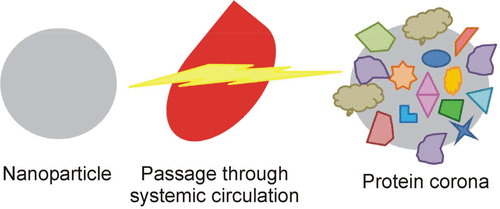当前位置:
X-MOL 学术
›
Mol. Pharmaceutics
›
论文详情
Our official English website, www.x-mol.net, welcomes your feedback! (Note: you will need to create a separate account there.)
How Corona Formation Impacts Nanomaterials as Drug Carriers.
Molecular Pharmaceutics ( IF 4.5 ) Pub Date : 2020-01-15 , DOI: 10.1021/acs.molpharmaceut.9b01111 Munishwar Nath Gupta 1 , Ipsita Roy 2
Molecular Pharmaceutics ( IF 4.5 ) Pub Date : 2020-01-15 , DOI: 10.1021/acs.molpharmaceut.9b01111 Munishwar Nath Gupta 1 , Ipsita Roy 2
Affiliation

|
As drugs/drug carriers, upon encountering physiological fluids, nanoparticles adsorb biological molecules almost immediately to form a biocorona, which is often simply called a corona. Once the corona is formed, it dictates the subsequent fate of the drug nanoparticle as a therapeutic agent. Protein adsorption on micron-size or even bigger particles was originally described by the Vroman effect. It has served as a useful framework to understand the corona formation. Proteins that are irreversibly adsorbed on nanoparticles form what is called a hard corona. Beyond that is the exchangeable population of proteins, which constitute the dynamic structure called a soft corona. More than the abundance, the affinity of the proteins toward the nanoparticles decides which ones end up in the corona. For example, the more common serum albumin, which is deposited initially, is displaced by fibrinogen, which has a higher affinity for gold nanoparticles. The curvature of the particle is a crucial parameter with bigger particles generally able to bind a more diverse population of proteins from the physiological milieu. The earlier perception of the corona formation being a challenge for drug targeting, etc. has been turned into an opportunity by engineering corona to manipulate properties like circulating half-lives, capacity to evade the immune system, and targeting or even overcoming the blood-brain barrier. The most commonly used techniques for particle characterization, including dynamic light scattering (DLS), differential sedimentation centrifugation, transmission electron microscopy (TEM), and SDS-PAGE, have been adopted to study corona formation in the past. Many newer tools, for example, a combination of capillary electrophoresis with mass spectrometry, are being used to study the corona composition. The comparison of interlaboratory results is a problem because of the lack of standard protocols. This has hindered the ability to obtain more precise information about the corona composition. That, in turn, affects our prospects to use nanoparticles as drugs/drug carriers. This overview is an attempt to assess our understanding of corona formation critically and to outline the complexities involved in gaining precise information. The discussion is largely focused on findings of the last year or so.
中文翻译:

电晕的形成如何影响作为药物载体的纳米材料。
作为药物/药物载体,纳米颗粒在遇到生理流体时几乎立即吸收生物分子,形成生物电晕,通常简称为电晕。电晕一旦形成,就决定了药物纳米颗粒作为治疗剂的后续命运。最初通过弗罗曼效应描述了蛋白质在微米甚至更大颗粒上的吸附。它已成为了解电晕形成的有用框架。不可逆地吸附在纳米颗粒上的蛋白质形成所谓的硬质电晕。除此之外,还有可交换的蛋白质种群,它们构成了称为软电晕的动态结构。蛋白质与纳米粒子之间的亲和力不仅决定其丰度,还决定了哪种蛋白质最终会进入电晕。例如,更常见的血清白蛋白 最初沉积的纤维素被纤维蛋白原取代,纤维蛋白原对金纳米颗粒具有更高的亲和力。颗粒的曲率是关键参数,较大的颗粒通常能够结合来自生理环境的更多种类的蛋白质。通过对电晕进行工程改造来操纵诸如循环半衰期,逃避免疫系统的能力以及靶向甚至克服血脑等特性的早期机会已被认为是电晕形成对药物靶向的挑战等。屏障。过去,最常用的颗粒表征技术包括动态光散射(DLS),微分沉降离心,透射电子显微镜(TEM)和SDS-PAGE,已用于研究电晕的形成。许多较新的工具 例如,将毛细管电泳与质谱结合使用来研究电晕成分。由于缺乏标准协议,实验室间结果的比较是一个问题。这阻碍了获得有关电晕组成的更精确信息的能力。反过来,这影响了我们使用纳米颗粒作为药物/药物载体的前景。本概述旨在评估我们对电晕形成的理解,并概述获得精确信息所涉及的复杂性。讨论主要集中在去年左右的调查结果上。这阻碍了获得有关电晕组成的更精确信息的能力。反过来,这影响了我们使用纳米颗粒作为药物/药物载体的前景。本概述旨在评估我们对电晕形成的理解,并概述获得精确信息所涉及的复杂性。讨论主要集中在去年左右的调查结果上。这阻碍了获得有关电晕组成的更精确信息的能力。反过来,这影响了我们使用纳米颗粒作为药物/药物载体的前景。本概述旨在评估我们对电晕形成的理解,并概述获得精确信息所涉及的复杂性。讨论主要集中在去年左右的调查结果上。
更新日期:2020-01-26
中文翻译:

电晕的形成如何影响作为药物载体的纳米材料。
作为药物/药物载体,纳米颗粒在遇到生理流体时几乎立即吸收生物分子,形成生物电晕,通常简称为电晕。电晕一旦形成,就决定了药物纳米颗粒作为治疗剂的后续命运。最初通过弗罗曼效应描述了蛋白质在微米甚至更大颗粒上的吸附。它已成为了解电晕形成的有用框架。不可逆地吸附在纳米颗粒上的蛋白质形成所谓的硬质电晕。除此之外,还有可交换的蛋白质种群,它们构成了称为软电晕的动态结构。蛋白质与纳米粒子之间的亲和力不仅决定其丰度,还决定了哪种蛋白质最终会进入电晕。例如,更常见的血清白蛋白 最初沉积的纤维素被纤维蛋白原取代,纤维蛋白原对金纳米颗粒具有更高的亲和力。颗粒的曲率是关键参数,较大的颗粒通常能够结合来自生理环境的更多种类的蛋白质。通过对电晕进行工程改造来操纵诸如循环半衰期,逃避免疫系统的能力以及靶向甚至克服血脑等特性的早期机会已被认为是电晕形成对药物靶向的挑战等。屏障。过去,最常用的颗粒表征技术包括动态光散射(DLS),微分沉降离心,透射电子显微镜(TEM)和SDS-PAGE,已用于研究电晕的形成。许多较新的工具 例如,将毛细管电泳与质谱结合使用来研究电晕成分。由于缺乏标准协议,实验室间结果的比较是一个问题。这阻碍了获得有关电晕组成的更精确信息的能力。反过来,这影响了我们使用纳米颗粒作为药物/药物载体的前景。本概述旨在评估我们对电晕形成的理解,并概述获得精确信息所涉及的复杂性。讨论主要集中在去年左右的调查结果上。这阻碍了获得有关电晕组成的更精确信息的能力。反过来,这影响了我们使用纳米颗粒作为药物/药物载体的前景。本概述旨在评估我们对电晕形成的理解,并概述获得精确信息所涉及的复杂性。讨论主要集中在去年左右的调查结果上。这阻碍了获得有关电晕组成的更精确信息的能力。反过来,这影响了我们使用纳米颗粒作为药物/药物载体的前景。本概述旨在评估我们对电晕形成的理解,并概述获得精确信息所涉及的复杂性。讨论主要集中在去年左右的调查结果上。











































 京公网安备 11010802027423号
京公网安备 11010802027423号